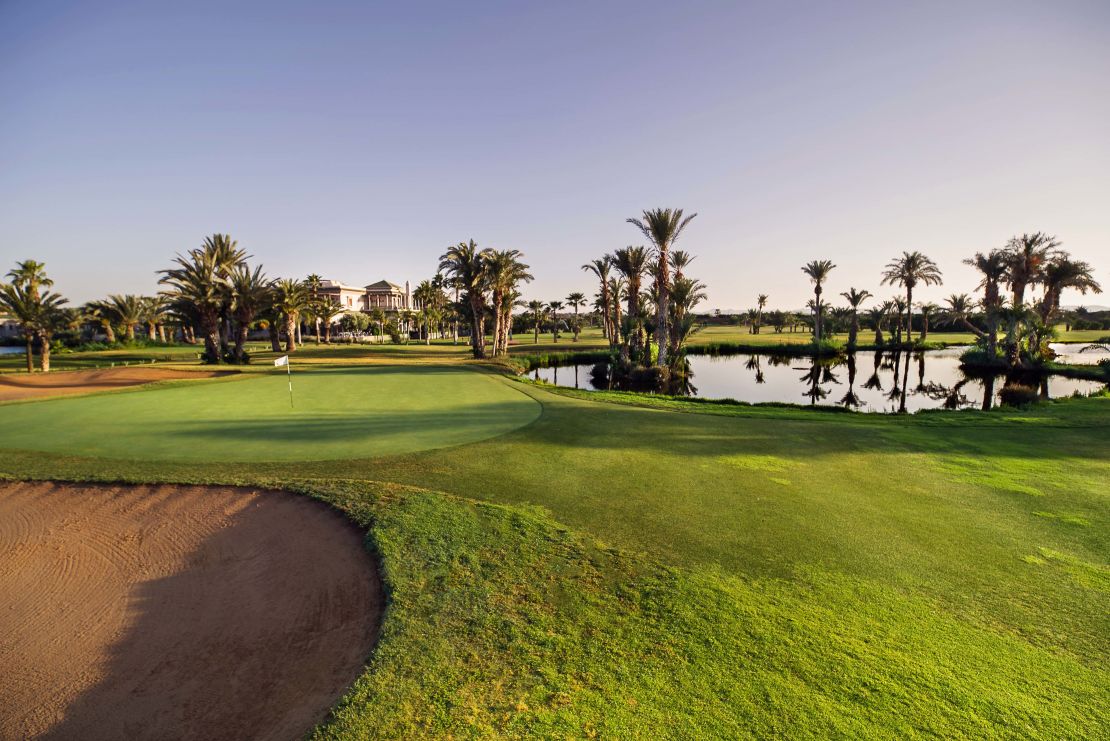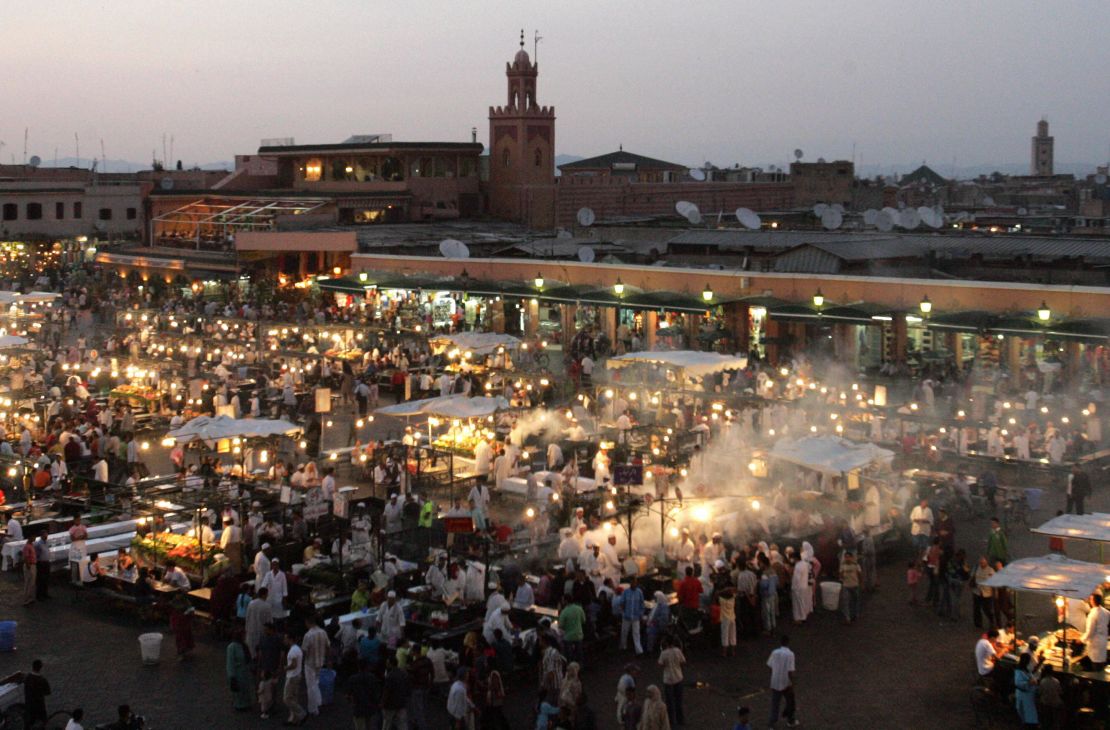For those eyeing a sun-kissed golfing trip in the Mediterranean, Spain has long been first choice. Yet across the Strait of Gibraltar, a new challenger is emerging.
Morocco is staking its claim as an enchanting North African alternative to the well-trodden golfing hotspots on the Iberian Peninsula, with the “Red City” of Marrakech leading the way.
Framed by the High Atlas in the distance, the city’s cacophony of narrow streets, surrounded by arid desert, may seem like a hostile environment for golf. Yet venturing out just past the bustling ancient medina and souks reveals a flourish of sprawling fairways, with more than 10 lush courses to choose from.
These emerald oases hidden around Marrakech include Golf Club Rotana Palmeraie, a 60-hectare course just a 20-minute drive north of the city center.
Splayed out on the doorsteps of 11 riad-style five-star hotel suites, the 18-hole course is the brainchild of legendary English-American golf architect Robert Trent Jones Sr, whose fabled career saw him inducted into the World Golf Hall of Fame before his death in 2000.

Seven lakes intersect a 6,214-meter setup inundated with palm trees, which are an attractive resting spot for storks. The sight of the large wading birds swooping down, Atlas Mountains towering in the background, makes for memorable moments for players, who typically come from France, the United Kingdom and Nordic countries.
“It truly is a haven for golfers, where natural beauty meets strategic challenge,” club manager Yohan Fernandez told CNN.
“This lush environment not only adds beauty but also makes each round feel unique and immersive, allowing golfers to enjoy the natural surroundings as they play.”

Growth
Barely 30 years old, Rotana is a relatively new course, but in terms of Moroccan golf, it is an antique.
It became just the second playable course in Marrakech when it opened in 1993, though its age is no match for the city’s oldest club, the 27-hole Royal Golf Marrakech.
Founded in 1927, the course has been played by two British wartime Prime Ministers, David Lloyd George and Winston Churchill, and former US President Dwight Eisenhower.
Dotted with more than 15,000 palm, eucalyptus and olive trees, the layout was designed by French professional golfers Gustave Golias and Arnaud Massy, the latter of whom remains the only Frenchman to win a major, with his triumph at the 1907 Open Championship.
At least six courses have sprung up around Marrakech in the last 15 years, a proliferation in line with Africa’s rising interest in golf. There were 594,000 9 and 18 hole golfers across the continent in 2022, according to the R&A’s annual global report, a sharp rise from the 370,000 recorded in 2016.

With roughly 25,000 golfers, Morocco was Africa’s fourth ranked country in terms of participation, well behind the overwhelming leader South Africa (450,000) but only narrowly adrift of Kenya and Nigeria.
That growing interest may go some way to explaining the burgeoning spread of Marrakech courses, from the Fairmont Royal Palm Golf and Country Club based at a luxury resort to the quirky Noria Golf Club, which boasts an eye-catching tented clubhouse and a huge reflective pool that splits the 9th and 18th holes.
“Marrakech has seen significant growth in golf courses over the past 10 years,” Fernandez said.
“Thanks to its year-round sunny climate and proximity to Europe, it attracts golfers looking to escape the cold and rainy seasons, being just a few hours’ flight away. It’s an ideal destination for short yet memorable golfing trips.”
The art of hospitality
Another reason for golf’s boom in the area is undoubtedly linked to the allure of the Red City as an offering away from the fairways, with its abundance of palaces, gardens, mosques, markets and more to explore.
La Porte d’Or, a two-level bazaar crammed with rugs and antiques, represents just one of myriad opportunities to bargain. The beating heart of the medina, a UNESCO World Heritage Site, is Jemaa el-Fnaa square, which at night becomes a bustling hub of food stalls and street entertainers.

Those looking for a change of pace can lose themselves in a host of museums across the city, be it the House of Photography or the Museum of the Water Civilization, a love letter to the history of hydraulic engineering in Morocco.
Another is the Yves Saint Laurent Museum, home to many works of the legendary French fashion designer and adjacent to his former residence, the breathtaking Jardin Majorelle, a 9,000-square-meter botanical garden that blends Moorish and art deco features.
Saint Laurent’s love affair with Marrakech – the influence for much of his work – began when he first visited the city with partner Pierre Bergé in 1966, with the pair buying the Majorelle property in 1980. A single ticket grants visitors access to both the museum and the garden, though the latter is temporarily closed for renovation.
Tying it all together for travelers is a rich variety of hospitality options, from the many riads – traditional Moroccan houses built around a central garden or courtyard – to the Royal Mansour Marrakech, a luxury hotel that was honored with the Art of Hospitality Award by The World’s 50 Best Hotels in August 2024, and provides each guest with a personal butler.
The hotel was one of many sites in Marrakech left damaged by a devastating 6.8 magnitude earthquake that hit central Morocco in September 2023, the most powerful quake recorded in the region in more than a century.
Yet the country’s tourism industry has bounced back in the wake of disaster. After welcoming a record 14.5 million tourists in 2023, the Moroccan Ministry of Tourism reported a 14% rise in tourist visits across the first six months of 2024 compared to last year, with a record 10 million arrivals tallied through July.
This story was updated to clarify that Golf Club Rotana Palmeraie is the second-oldest in Marrakech.












